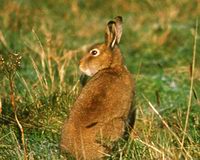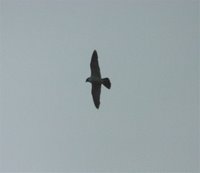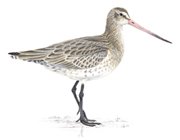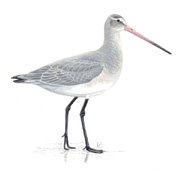Well I looked out of my living room window and there were two hares.The Irish hare only occurs in Ireland – it is a sub-species of the mountain hare which occurs in the rest of the UK. The Irish hare is a native species with a russet brown coat, long ears with black tips and eyes set high in the head, which gives it a wide field of view for evading predators.
 Irish hares occur in a wide range of habitats, including lowland raised bogs, blanket bog, grasslands and sand dunes. In my case grassland. This is the first time this year I have seen them in the field. As I was looking at them with my lovely lightweight Leica 10 *25's I noticed two Red Legged Partridge walking directly behind them, neither seemed concerned with each other.
Irish hares occur in a wide range of habitats, including lowland raised bogs, blanket bog, grasslands and sand dunes. In my case grassland. This is the first time this year I have seen them in the field. As I was looking at them with my lovely lightweight Leica 10 *25's I noticed two Red Legged Partridge walking directly behind them, neither seemed concerned with each other.On flightline there was a message that a little ringed plover had been seen at the RSPB Belfast Harbour Reserve so I popped upto Belfast for 11'o'clock. The Hide was closed until 1.00pm and as there were quite a few birders hanging around I opened up and stayed until the afternoon volunteer arrived. I am very glad I did.
 We couldnt find the Little Ringed Plover but were entertained massively by a Peregrine diving into the flocks of Common Terns, Black Tailed Godwit and Dunlin. It caused absolute mayhem. It was unsuccessful and would fly quite high over the reserve before diving back down again. This carried on for five minutes and was very spectacular. Meanwhile the godwits were flying in circles but increasing their altitude to get out of the diving range.
We couldnt find the Little Ringed Plover but were entertained massively by a Peregrine diving into the flocks of Common Terns, Black Tailed Godwit and Dunlin. It caused absolute mayhem. It was unsuccessful and would fly quite high over the reserve before diving back down again. This carried on for five minutes and was very spectacular. Meanwhile the godwits were flying in circles but increasing their altitude to get out of the diving range.  The Peregrine photos are a bit too far for my 400mm lens and I had great difficulty tracking it. It then flew of towards The Harland and Wolff Giant cranes.
The Peregrine photos are a bit too far for my 400mm lens and I had great difficulty tracking it. It then flew of towards The Harland and Wolff Giant cranes.I met a few new birders to me a couple of Ian's and George Gordon who runs Flightline so efficiently. Georgetold me about the differences in spotting a Bar Tailed Godwit to a Blacktail Godwit. I saw a bartail at the far side of the reserve which I couldnt really identify apart from the fact it looked like a godwit. One of the main things to look out for is the tibia length. It is shorter in a bartail as opposed to a blacktail
 . Now to demonstrate my observation skills. After I left Belfast I stopped in the Castle Island Hide on the way home where there was another birder who mentioned
. Now to demonstrate my observation skills. After I left Belfast I stopped in the Castle Island Hide on the way home where there was another birder who mentioned  Black Tailed Godwit on the far side of the pondage. So I regaled him with the differences of the two types of Godwit that I had just learnt and he said " I know I told you in the hide in Belfast"!!!!!! Well George it was nice to meet you and I will try to remember you the next time. Just make sure you are wearing the blue hat.
Black Tailed Godwit on the far side of the pondage. So I regaled him with the differences of the two types of Godwit that I had just learnt and he said " I know I told you in the hide in Belfast"!!!!!! Well George it was nice to meet you and I will try to remember you the next time. Just make sure you are wearing the blue hat.
No comments:
Post a Comment